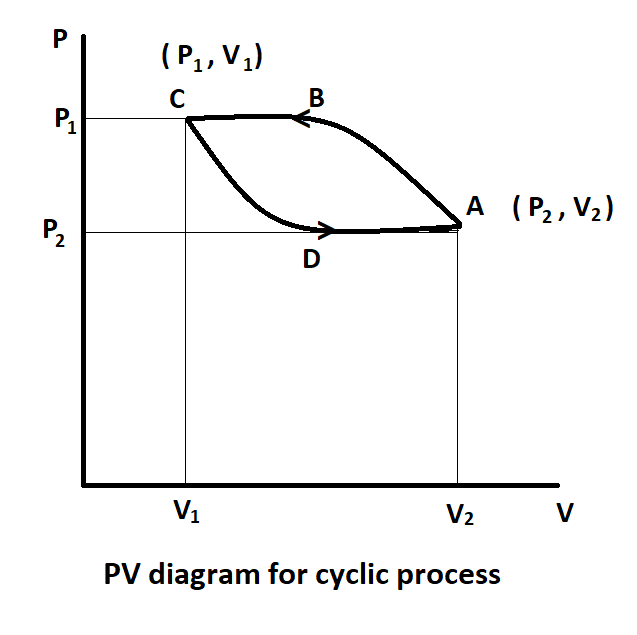
For a cyclic process which of the following quantities is zero?
A. $\Delta V$
B. $\Delta U$
C. W
D. $\Delta Q$
Answer
579.9k+ views
Hint: To solve this question, we have to remember that any cyclic process has an initial state the same as the final state. So, if any quantity is zero in a cyclic process it means it depends on the state of the process and not on the process using which it has reached that state. So, find which of the given quantities is a state function to get the answer.
Complete step by step answer:
As we know that in thermodynamics entropy, enthalpy and internal energy is a state function and rest all are path functions.
Now in the given question a cyclic process is given which means a process which starts from a certain state and finally ends at the same state at which it was started.
So, if total change in any quantity is zero it means that process only depends on the state of the system because when there will be no change in state then there will be no change in quantity as well.
Now since in the given options, heat and volume and work done all are path functions except the internal energy.
Hence change in internal energy will be zero.
Therefore, the correct answer is option (B).
Note:
Let a process occur from state 1 to 2 from path A. Internal Energy change can be determined between state 1 and 2. If the process would have followed path B then also the change in internal energy would be the same as in case of path A. So, internal energy depends on states and not on the path. Thus, it is a State Function.

Complete step by step answer:
As we know that in thermodynamics entropy, enthalpy and internal energy is a state function and rest all are path functions.
Now in the given question a cyclic process is given which means a process which starts from a certain state and finally ends at the same state at which it was started.
So, if total change in any quantity is zero it means that process only depends on the state of the system because when there will be no change in state then there will be no change in quantity as well.
Now since in the given options, heat and volume and work done all are path functions except the internal energy.
Hence change in internal energy will be zero.
Therefore, the correct answer is option (B).
Note:
Let a process occur from state 1 to 2 from path A. Internal Energy change can be determined between state 1 and 2. If the process would have followed path B then also the change in internal energy would be the same as in case of path A. So, internal energy depends on states and not on the path. Thus, it is a State Function.

Recently Updated Pages
Master Class 11 Economics: Engaging Questions & Answers for Success

Master Class 11 English: Engaging Questions & Answers for Success

Master Class 11 Social Science: Engaging Questions & Answers for Success

Master Class 11 Biology: Engaging Questions & Answers for Success

Class 11 Question and Answer - Your Ultimate Solutions Guide

Master Class 11 Business Studies: Engaging Questions & Answers for Success

Trending doubts
What is meant by exothermic and endothermic reactions class 11 chemistry CBSE

10 examples of friction in our daily life

One Metric ton is equal to kg A 10000 B 1000 C 100 class 11 physics CBSE

Difference Between Prokaryotic Cells and Eukaryotic Cells

What are Quantum numbers Explain the quantum number class 11 chemistry CBSE

1 Quintal is equal to a 110 kg b 10 kg c 100kg d 1000 class 11 physics CBSE




